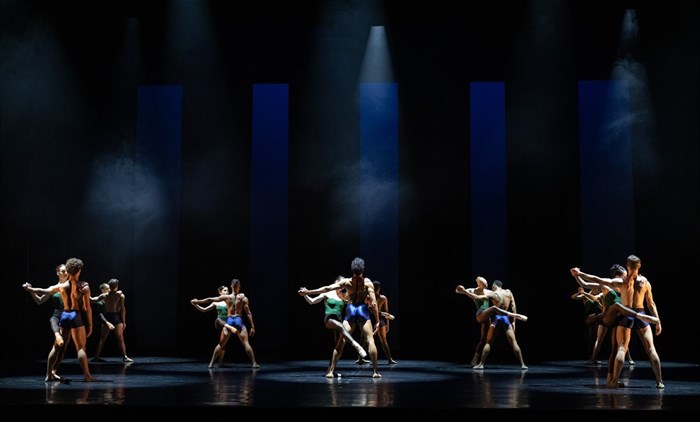Triple bill conveys Japanese philosophy of purpose, happiness and peace

Jiří Kylián’s Falling Angels is a work for eight women made to a very strict musical structure provided by Steve Reich that nevertheless allows them freedom for choreographic and emotional interpretation. The result is a study of opposites – discipline and freedom, belonging and independence.
Several of these young dancers have worked with world-renowned choreographers before, but Kylián’s particular approach is unsurpassed. Anybody who has ever seen performances by his Nederlands Dans Theater, Nederlands Dans Theater II and Nederlands Dans Theater III will surely agree.
Kylián has countless accolades to his credit and served as a mentor in Dance for the Rolex Mentor and Protégé Arts Initiative in 2010. He has done work for several acclaimed dance companies, and meeting his exacting standards is daunting, to say the least.
However, répétiteur Elke Schepers made certain of success when she set the work on Cape Town City Ballet dancers last year. The women dance in black unitards with short legs, exposing well-defined arms and legs under bright white lights that dissect the stage at intervals to showcase group work as well as solos.
It’s all about the body, and less about the face. The stark visual effect underpins the energetic group spirit demonstrated with staccato movements performed largely in unison with relentless percussion. The audience was mesmerised, and I’m sure I wasn’t the only one twitching involuntarily in my seat in anticipation of the next move.

Frederick Ashton’s Les Patineurs, first created in 1937, is an exercise in charming escapism. Set to music from Giacomo Meyerbeer’s operas, and arranged by former Vic-Wells Ballet’s music director Constant Lambert, this piece was accompanied by the Cape Philharmonic Orchestra with Hong Kong-born Briton Jonathan Lo on the podium.
Set on an ice rink in a park, the cast did a wonderful job of portraying skaters’ movements, especially in entrances, exits and (choreographed) mishaps. I loved the set and the winter wardrobe complete with faux fur trimmings. Tiny details make all the difference.
And then there were the smiles. The cast could have fun with this one. The brief was literally to enjoy themselves! Principal couple Kirstél Paterson and Brandon Lawrence, also from Birmingham Royal Ballet, danced their pas de deux with panache making the most of their upside-down split sequence, which had the audience giggling with delight.
Taiwanese Tzu-Chao Chou was the proverbial dynamite in a small package. The principal guest artist from Birmingham Royal Ballet said he was on “cloud nine” in an Instagram post after his debut as the Blue Boy – a feeling we could sense from the second he “skated” beaming onto the stage. His is the kind of seemingly effortless performance you never want to end. It’s sheer perfection.

Kenneth Tindall, resident choreographer and director of digital for Northern Ballet, staged an extended version of Polarity, which he created for Cape Town City Ballet in 2019. Challenging choreography incorporating strenuous steps, gravity-defying lifts and leaps executed with military precision push the company into a performance space they know well.
Gemma Trehearn impresses with her time in the spotlight and I really enjoy watching her partner by Jan Kotzé albeit briefly. Theirs is one of my favourite partnerships, strengthened by the familiarity that comes with years of training together since they were students. Again there is a sense of accomplishment and confidence among the cast, who maintain a largely serious look for this piece with a glimmer of a smile escaping here and there. Until Brazilian Lêusson Muniz takes the stage…
Who better to portray Tindall’s theme of interconnectedness, harmony and balance, than he and Kirstel Paterson? They have a growing fan base already, bolstered by their performances in the title roles of Romeo and Juliet in the concurrent season, but their pas de deux in Polarity had no acting requirement and was just as powerful. Paterson simply glows under Muniz’s expert partnering. Her only rival in the smile stakes was Kotzé. Both of them transform when they really let go, which is a pleasure to see.

I’m emphasising the smile factor because it links back to Ikigai – purpose, happiness and peace. It’s a journey not only for the audience but the dancers too. For me, mastering facial expression is one of the most important things for a successful artist.
The dancers project into a cavernous expanse of nothingness, punctuated only by a tiny light or screen to indicate the midpoint of the stage, unable to connect visually with most of their audience. Those who can sell their story convincingly, moving people to feel something beyond admiration for physical aptitude, get my vote every time.
Ikigai is running until 28 August at the Artscape Opera House. Tickets are available through Computicket or Artscape Dial-A-Seat 021 421 7695.


















